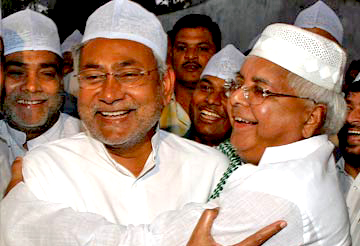New Delhi, Jul 28: They have been the most bitter rivals for over two decades. But a common need to defeat the BJP has brought Bihar stalwarts Nitish Kumar and Lalu Prasad Yadav on the same side of an electoral battle.
 The two former chief ministers will share stage while campaigning for by-elections to 10 assembly seats to be held on August 21. Nitish Kumar's Janata Dal (United), decimated in the general elections by the BJP-led NDA of which it was a part for 17 years, is now partnering with Lalu Yadav's Rashtriya Janata Dal and the Congress.
The two former chief ministers will share stage while campaigning for by-elections to 10 assembly seats to be held on August 21. Nitish Kumar's Janata Dal (United), decimated in the general elections by the BJP-led NDA of which it was a part for 17 years, is now partnering with Lalu Yadav's Rashtriya Janata Dal and the Congress.
The RJD and Janata Dal will contest four assembly seats each and the Congress will contest two - a formal announcement is expected later this week.
The JD(U) rules Bihar with a depleted strength after the split last year with the BJP engineered by Nitish Kumar, who stepped down as chief minister after his party's disastrous showing in the Lok Sabha elections in May. Hit also by multiple desertions in a bad political year, the JD(U) is now supported by the RJD and Congress in the Assembly.
The BJP's new partner Chirag Paswan of the LJP (Lok Janshakti Party) mocked the alliance saying, "When we joined the NDA Nitish ji had said 'strange but true'. I would like to say the same today. They used to once sit like kings in their homes and distribute ticket. Today they have been reduced to sharing these seats."
"The situation is very clear. Two people who have lost have come together. They are just trying to save their political status. They are just making this alliance to create an illusion," said Bihar BJP President Mangal Pandey.
Bashisht Narayan Singh, JD(U) Bihar unit chief said, "This alliance is the need of the hour to defeat communal forces. I agree that Nitish and Lalu had differences but there is a lot in common too, especially the socialist agenda."
Mr Singh pointed out that the combined vote share of the three parties in the Lok Sabha elections was more than that of the NDA. He also blamed the BJP for their split.
Nitish Kumar had in June last year called off the partnership once it became clear that arch political rival Narendra Modi could be the BJP's choice for Prime Minister in the general elections.
The JD(U) has 114 seats, the BJP 89, the RJD 24 and the Congress 4 in the 233-member Assembly.





Comments
Add new comment